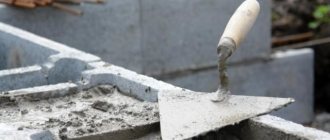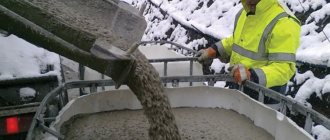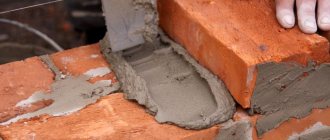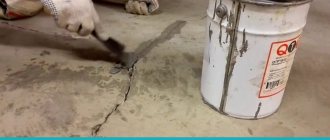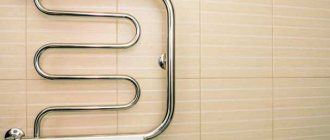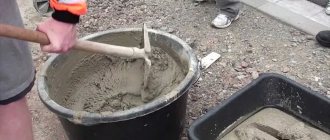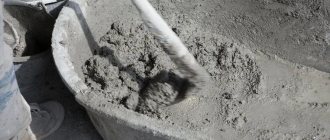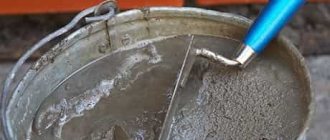The construction of swimming pools at dachas or in country houses is no longer some kind of luxury or curiosity. Each owner of a country property decides for himself whether he needs a pond near his house or whether he prefers water treatments on public, crowded beaches.
For many in the summer, swimming pools near the house are simply a necessity, since dacha concerns take up most of the time, and you don’t want to go somewhere through traffic jams or off-road. And then - once - and you escape from the heat in a pool you built with your own hands.
The choice of pools today is huge. You can simply buy yourself an inflatable bowl - and also swim in it. And by winter, blow it off and put it in the basement. But practical summer residents are increasingly giving preference to concrete pools. What type of concrete should I use for my pool? Find out in our article which grades of concrete are suitable for pouring a swimming pool.
Types of effective additives and their mechanism of action
- Plasticizers: “Suprplasticizer S-3”, “Superplast” and component D5. All types of plasticizers have the same mechanism of action - the formation of a persistent waterproof film around cement particles and the creation of an electrical charge. This greatly activates the finished concrete and it compacts well;
- Colmat additives: bitumen emulsion, calcium nitrate, aluminum sulfate, iron sulfate and nitrate. They also significantly increase the density of the poured structure. The desired effect is obtained as a result of a chemical reaction between the additive, water and the binder - the formation of water-insoluble compounds that reliably “clog” all pores and even significant voids (colmatation process);
- Polymer additives: methyl cellulose, cellulose methyl ether, as well as diethylene glycol, triethylene glycol and polyamide resins. This type of additive provides the highest level of water resistance. The required effect is ensured by enveloping the particles of concrete components and forming a very strong waterproof polymer film on them.
You should know! Only a monolithic concrete structure can be made waterproof: a monolithic foundation, a pool or well bowl, a reservoir, etc. It is impossible to make prefabricated concrete structures 100% waterproof by any means or technologies!
Crafting recipe
An equal amount of both additives should be mixed. That is, you need to use 4 liters of additives per cubic meter of concrete. That is, for a concrete mixer that mixes 100 liters of concrete at once, no more than 0.4 liters of special additives should be used.
For 50 kilograms of cement you need to take approximately 20 liters of water, 0.4 liters of additives, 60 kilograms of sand and 110 kilograms of crushed stone. The number of components can be varied depending on the desire to enhance a particular property of concrete.
If you need to make concrete for the most difficult areas where additional strength is required, then for 80 kilograms of cement you need 60 kilograms of sand, 120 kilograms of crushed stone, no more than 17 liters of water and half a liter of Betonoprava.
If you need to make not only frost-resistant, but also waterproof concrete, then you also need to add Dehydrol.
To immediately determine the plasticity of the mass, you need to pour water into the concrete mixer, and then the additive.
Then the remaining components are added in the required quantities. The mass is mixed, and in 5 minutes it will be ready. You can apply the mass where it is needed. All that remains is to wait until everything freezes.
It is important to remember that the volume of water should not exceed the weight of concrete by more than 35%. For 50 kilograms of cement you need to use no more than 20 liters of water.
The less water used in making concrete, the stronger it will be. Also, one should not forget about the mass of cement. For one cubic meter of concrete, 350 kilograms of cement are taken.
Source
How to determine if concrete is permeable to water
In practice, precise methods are used, using special equipment, and are more accessible for private construction projects. The most common absorption tests are:
- on a wet spot, when a stream of water under high pressure is applied to a prototype placed in the apparatus;
- by filtration coefficient, when the sample is placed in the apparatus and compressed under high pressure;
- according to the binders used, the type of filler and the plasticizers added to the solution.
To maintain waterproofing properties and high resistance to moisture, cement must be stored in proper conditions. Only if the storage conditions are observed can you count on the declared consumer properties.
Types of waterproof cements
According to the mechanism for achieving the goal, the following main types of material are distinguished: waterproof expanding cement; waterproof non-shrinking cement and cement with hydrophobic filling. The mechanism of the protective functions of the expanding composition is based on the fact that a substance is introduced that causes the mixture to expand during pouring and rapid hardening. The principle of operation of the non-shrink method involves the addition of an ingredient that ensures the formation of crystals that compact the structure of the material during hardening without free expansion of volume. The introduction of hydrophobic components into the structure of the cement mixture is explained by their protective functions upon contact with penetrating water (they expand, chemically bind, form crystalline structures, etc.).
Pros and cons of antifreeze impurities
The positive aspects of use are:
Such substances allow the necessary work to be carried out even in winter.
- carrying out work on the construction of concrete structures even in cold weather;
- increasing the strength of the building as a result of increasing the adhesion reaction;
- use of the product in industry;
- increasing service life;
- increase in frost resistance, moisture permeability;
- low cost of additives;
- acceleration of hardening of the concrete mixture;
- ease of shaping due to increased mobility;
- unchanged solution structure.
However, builders also highlight disadvantages:
- using more cement;
- toxicity of some substances included in the composition;
- reduction in the declared power and strength of the concrete product;
- increased risk of corrosion.
Why is reinforced concrete waterproofing needed?
Before considering what is added to concrete to make it waterproof, it is necessary to understand what structures are desired to be protected and why. Thus, reinforced concrete necessarily needs protection from moisture, since exposure to water destroys both concrete and reinforcement, which negatively affects the level of strength, ability to withstand loads, service life, etc.
Concrete does not deteriorate immediately, but gradually, and the speed depends directly on the corresponding indicator. They are designated by the letter F and a number (F100, F200, F300, etc.), which indicates the number of freezing/thawing cycles that a concrete monolith can survive.
The reinforcement that is poured inside the stone also needs protection from water to increase its strength characteristics and level of resistance to various types of loads. When water gets into the concrete and reaches the reinforcement, the metal oxidizes: it becomes thinner (the bearing capacity of the rods decreases), metal oxide appears (the volume increases, the concrete collapses).
Aggressive types of water are dangerous for concrete and metal - leaching, carbon dioxide, oxygen, sulfate, general acid, magnesium. For stone, the most harmful are waters with sulfuric acid salts, which provoke chemical reactions and loss of strength. For metal, any water can cause destruction.
Price
Additives to concrete for waterproofing (you can buy the material at any hardware store) do not have a significant impact on the cost of the work. All systems have an affordable price, from 72 rubles/kg , and are presented in a wide range. The most expensive systems are the Penetron brand, the cost of which exceeds 300 rubles/kg.
The properties of the concrete waterproofing additive Penetron Admix are described in the video:
How to make concrete waterproof
Currently, the construction business is developing at a very rapid pace throughout the world. Every year thousands of buildings and structures are erected and reconstructed, new building materials and substances (additives) are synthesized that improve the quality of structures and increase their strength. Much attention in this area is paid to the foundation. It is the basis of any building or home. The durability of the structure itself largely depends on its strength and durability. A mixture is most often used to make the foundation. Concrete is an artificial building material with high strength, obtained by mixing various ingredients: sand, crushed stone, cement powder and water.
The mixture is used at any stage of construction - from pouring the foundation to screeding the floor and leveling the walls.
Often some special additives are introduced into it, which increase its strength and wear resistance. These include water repellents, which increase resistance to moisture. Hygroscopicity is an important property that protects the structure from water. But not all building materials meet such requirements. Let's take a closer look at how to make concrete waterproof, the necessary materials, mixtures and solutions.
Material selection
Regular concrete is easy to make, but you need to make frost-resistant concrete. As an additive that will provide a frost-resistant effect, Dehydrol Lux 10-2 is taken. It is also called “Liquid Waterproofing Hyperconcentrate”.
The same component is used in the manufacture of waterproof concrete. But this is not the only additive.
You will also need Betonoprav lux 2 or “Liquid additive for corrosion-resistant concrete.” The recipe for making concrete is quite simple. It does not take a lot of time.
Waterproofing the basement from the inside from groundwater
The basement is protected from water in two formats: vertical waterproofing of the walls is performed (if there is no drainage and the basement part is at the groundwater level) and horizontal (the base is treated at the groundwater level). Both methods or one can be chosen, it all depends on factors such as the quality of insulation and foundation material, the level of groundwater and precipitation, operating conditions and purpose of the room, the presence of drainage, etc.
Basement walls from the inside can be protected in several ways - use vertical methods: membranes, rolls, coating materials, plastering, forming a barrier of liquid glass or rubber. Typically, such options are suitable where there is no properly installed drainage system.
Horizontal protection against water is carried out along the floor, preventing the rise of water from the ground or the seepage of moisture through the capillaries of concrete. This type of protection is desirable in any case, regardless of the type of structure and the characteristics of the soil and climate. For protection, roll materials or concrete with waterproof polymer additives are used. The water resistance of additives must be very high in order for the protection to be of high quality.
To prevent capillary penetration of moisture into the room, it is advisable to implement both types of waterproofing. Vertical protection can be partially mounted by treating the walls at least 30 centimeters in height.
Do-it-yourself concrete additives for waterproofing
When thinking about what to add to concrete to prevent it from leaking water, you need to consider the main types of additives. They are usually divided into 3 groups: clogging, polymer, plasticizing.
Plasticizers
Such additives assume a single operating principle: when added to the mixture, they create a film-type coating that envelops cement particles and gives them the desired properties. The particles become more slippery and the concrete becomes more mobile. Some plasticizers can create an electrical charge, due to which the particles of the mixture are activated and it becomes more mobile.
As the plasticity of the concrete solution increases, the excess moisture content in it decreases and pore formation decreases. A plasticizing additive for concrete for water resistance is added to the mixture in a volume of 0.1-3% of the total mass. There are three types of plasticizers: highly effective, highly plasticizing and weakly plasticizing.
Colmatizing
Water-repellent additives for this type of concrete can be produced on the basis of different substances - iron sulfate/nitrate/chloride, aluminum sulfate, calcium nitrate, and bitumen emulsion are often used.
They all work on the same principle: they compact the concrete and make it impermeable to water after the monolith has hardened. This effect can be achieved through a chemical reaction between water, cement and the additive itself. Thanks to the reaction, insoluble compounds appear that reliably fill all the voids in the structure (pores and capillaries) of the frozen stone.
Clogging additives can also be applied to the monolith after the mixture has hardened - the components of the composition penetrate into the surface layer, filling the pores (the clogging process takes place).
Polymer
Water-repellent polymer additives in concrete guarantee the highest level of protection of the material from moisture. A durable polymer film is formed on all particles of the concrete mortar components, which reliably and efficiently protects the stone from water. Such additives make it possible to protect even destroyed structures - covered with cracks, chips, without allowing them to deform further.
Penetrating waterproofing
Hydrophobic penetrating additives also provide very high levels of effectiveness. They can work in different ways: introduced into the mixture during its preparation, or applied using technology to an already solidified monolith.
The composition of the mixtures varies; manufacturers today offer a large selection. Those with predominantly cement and sand simply create a crust on the surface. Substances with chemical compounds guarantee deep penetration into the monolith, filling pores and voids much more effectively.
Penetron
A very popular water-repellent additive for concrete. Provides waterproofness of reinforced concrete products during the process of pouring them, can be used for prefabricated/monolithic structures, even with pores and cracks. Reservoirs, swimming pools, foundations, basements, and septic tanks are often treated with this product.
The main advantages of the Penetron additive: environmental friendliness, safety for humans, the ability to combine with other additives, increasing the frost resistance of concrete, protection not only from ordinary water, but also from sea water, as well as acids, alkalis, wastewater, etc.
The additive is dissolved in water and mixed with the solution during its preparation. To ensure reliable waterproofing of seams, junctions, utility entries, etc. additionally install waterproofing gaskets.
Liquid glass - modern waterproofing
A type of silicate adhesive improves the performance characteristics of reinforced concrete products without significantly affecting their cost.
The material allows you to provide:
- waterproof;
- moisture resistance;
- heat resistance;
- resistance to fungal and mold attacks.
Liquid glass for concrete is used in the construction of foundations, including for hydraulic engineering, fireplaces, boilers, furnaces, and various underground reinforced concrete structures.
Self-construction involves using the following principles:
- at least 10% silicate glue is introduced into the concrete solution, which ensures optimal technical characteristics;
- silicates are not added to the finished solution. First, the dry components are combined, then glue is introduced, which is previously diluted with water;
- It is recommended to prepare solutions in small portions, since the additive accelerates hardening. Laying and pouring reinforced concrete should be carried out quickly.
For work, it is advisable to use concrete grades M400/M200. Failure to comply with the proportions will result in the finished structure falling apart the next day.
Sequencing:
- a glass of liquid glass is diluted in a bucket of purified water;
- the solution is thoroughly mixed;
- the additive is poured into a more convenient container, for example, a trough, and the dry mixture is introduced there;
- the mass is processed with a construction mixer;
- Do-it-yourself waterproof concrete is ready and can be poured into the formwork.
Waterproofing of finished reinforced concrete products is carried out using a primer with silicate glue. In private construction, a mixture of water, cement and liquid glass (1 liter of water/400 g of glue) is used for such purposes.
Painting waterproofing
Painting waterproofing of concrete is a rather complex and labor-intensive process that requires the use of special equipment. This method is more often used in the construction of large industrial facilities.
It is possible to make concrete waterproof using surfactants. They form a waterproof layer (film) on the concrete surface. These substances are applied using special equipment: pistols, sprayers. Most often, bitumen heated to high temperatures, mastics, emulsions and other mixtures are used. Some of them are not able to withstand low temperatures and often become covered with cracks. To give concrete special properties, its surface is carefully processed and cleaned before applying the painting material.
Then a layer of paint or any other mixture is applied, its thickness can be different, on average several millimeters. A layer of primer is placed on it. Currently, hydrophobic solutions based on organosilicate compounds are widely used. But they do not completely close the pores in concrete; therefore, they are only relevant for protection from precipitation and low water pressure. Fluates, salts of fluoric acid, are also highly effective. But they are only suitable for finely porous concrete. The use of bitumen mastic can give good results. It consists of bitumen and a mineral component (limestone, clay). Their ratio varies. The percentage of bitumen in the mixture ranges from 30 to 45%. Moreover, such a coating material has high frost resistance.
Tips for choosing impregnation
When choosing an impregnation for concrete, the following must be considered:
- Silicate (inorganic) compounds are used when:
- it is necessary to remove dust from the concrete floor at minimal cost;
- the concrete surface has significant unevenness and roughness;
- the floor will be subject to harsh use (dragging heavy objects, high temperature exposure).
- Polymer (organic) impregnations are best used in the following cases:
- intensive exposure to chemicals on concrete pavement;
- high requirements for the aesthetic appearance of a concrete floor;
- dust removal of mosaic floors.
When using impregnating compositions, the following requirements must be taken into account:
- no impregnation is applied to a fresh concrete floor, even if it is already possible to walk on it. At least two weeks must pass for the concrete to mature and gain the strength necessary for the application of impregnations;
- The concrete surface must be well dried. The presence of water in the pores of concrete is unacceptable. The floor must also be thoroughly cleaned of dust and dirt;
- It is best to apply impregnation at an air temperature of +20 - +25 degrees and humidity - no more than 90%;
- the temperature of the concrete floor should be at least +10 degrees, although some impregnations can be used at lower temperatures;
- Before applying water-repellent compounds, it is advisable to rub the concrete floor with fine quartz sand to give it anti-slip properties;
- all visible defects of the concrete coating must be removed - cracks and chips must be sanded;
- for work you should use brushes and rollers that are resistant to solvents;
- When working, it is necessary to observe safety precautions, using personal protective equipment (respirators, clothing made of cotton fabrics, shoes with rubber soles, gloves).
Coating option
To waterproof concrete surfaces, they are coated with special waterproofing compounds that penetrate into the thickness of the concrete and clog the pores.
Waterproof concrete can be obtained by applying coating materials to its surface. They can be used as hot mixtures based on bitumen and mastic. To do this, it is important to prepare the concrete surface for processing. She is being cleansed. Then 2 layers of primer are applied. The first includes a slow-acting solvent, the second - a fast-acting one. These layers contribute to better adhesion of the coating solution and the concrete surface. The coating material is applied in two layers. First one, then the second. Within a few minutes you can observe how a special protective film forms on the concrete.
This method is better than painting, as it is more durable. But it also has a number of disadvantages. The most important of them is that even with slight deformation of the concrete and its surface, the coating can collapse. In addition, there are often cases of coating dripping. The reason for this is the incorrect selection of mastic. It is very important to know that the coating is applied in 2 layers, each about 2 mm thick. After applying the feather coat, you need to carefully check the quality of the coating and only then continue working.
What are concrete floors on the ground?
From the name it may seem that this is a screed that is poured directly onto the native soil of the site. In fact, everything is much more complicated.
This floor is made of several layers:
- The base is carefully compacted soil
- From above it is leveled with a layer of sand and small crushed stone
- Next comes the so-called sub-concrete screed - a thin layer of low-quality concrete that forms a flat surface
- Hydro- and thermal insulation is laid on the concrete base
- And at the very end, a concrete screed is poured into the reinforcement frame
The result is a perfectly flat surface on which you can lay tiles or any other floor covering.
TOP products to add to the composition
Special products will also help improve the waterproofing properties of concrete mortar.
Crystal
The additive is considered the most famous on the Russian market. Dry, odorless powder is added to the concrete mixture. The granules react with salt-based plasticizers. The main advantages are efficiency and reduced consumption of building mixture. Using the product allows you to increase the water permeability of the material to W16, which provides reliable protection against moisture penetration into the concrete body. The strength of the building material doubles, and frost resistance increases by 60 cycles. Concrete can be used to arrange the bottom of a swimming pool or artificial reservoir. Find out about finishing one-component putty for cars in this article.
It is recommended to prepare the concrete mixture in a concrete mixer; the manual method of preparation does not allow achieving the desired quality of the solution. When preparing the mixture, you should strictly follow the instructions.
Homemade ways to improve waterproofing
You can also increase the waterproofing properties with improvised means, for this you can use household chemicals, PVA glue, and slaked lime. All components react with the concrete mixture in different ways; compliance with the dosage plays an important role.
All substances must meet the following requirements:
- absence of volatile components in the composition;
- eliminating the use of toxic substances;
- chemical resistance;
- the operating temperature must be higher than the destruction temperature of the additive composition.
Washing powder
Washing powder is used dissolved in water. The optimal effect is achieved by maintaining a proportion of 100 - 150 powder per 50 kg of cement.
When using powder, you should use types intended for automatic washing, since their use produces less foam.
Liquid soap or shampoo
Liquid soap should be mixed with cement in a ratio of 200 ml per bag of cement. When using detergents, preference should be given to products with reduced foaming.
PVA glue
Glue should be added to the solution in a proportion of 200 g per bucket of mixture. Limited use is due to the presence of starch in the composition.
Slaked lime
Chloride of lime is introduced into the mixture simultaneously with other components; its amount should not exceed 20% of the total volume. Unlike the quicklime formula, the additive increases the elasticity of the concrete solution and increases its adhesive properties.
How can a foundation be poured at a high level of hot water?
Using the pile method involves installing reinforced concrete pillars around the perimeter of the proposed structure.
There are 2 ways to pour concrete mixture in water: using piles and the caisson method. The pile method uses reinforced concrete pillars fastened with a tongue and groove. For this process, a special type of concrete is used, consisting of a saturated and unsaturated type with the addition of Portland cement. The first type of cement is more durable; it is laid out on the formwork; the second type is poured into the core of the structure being built. To prevent the mixture from leaking through the crushed stone, a tarpaulin is laid on the bottom, covering the formwork as well. When the bottom layer hardens, the next solution is poured on top to create a monolithic structure.
The caisson method is used in cases of strong underground flow or wave phenomena. In this case, the formwork is made of metal. In large construction areas, the caisson is assembled. Bags of concrete mortar are thrown into the pit. After they dissolve, the mixture will harden, forming a reliable bottom. After installing metal piles with a slight external slope, they are tied together with strong metal wire. Next, special pipes with cement are placed under water and the area is concreted.
Brands of moisture-resistant (hydraulic) concrete
B22.5M300 is considered a common brand in hydraulic construction. Its frost resistance is F100-F200, water resistance is W4-W10. When choosing a brand, the type of soil is taken into account; for clay surfaces, no less than M350 is suitable.
Table 1 – Brands of waterproof concrete
| Classes and grades of concrete | Frost resistance grades | Waterproof grades |
| B7.5M100 | Not standardized | W2 |
| B15M200 | F75-F150 | W2-W4 |
| B20M250 | F50-F200 | W2-W8 |
| B22.5M300 | F100-F200 | W4-W10 |
| B25M350 | F100-F300 | W4-W20 |
| B30M400 | F300 | W10 |
| B35M450 | F200-F300 | W8-W14 |
| B40M550 | F200-F300 | W10-W16 |
| B45M600 | F100-F300 | W12-W18 |
Differences in brands and areas of application:
- M100 is suitable for making borders;
- M150 - fencing is made from this concrete, the floor is poured;
- M200 is used for sidewalks and building renovation;
- M250 is multifunctional, suitable for the manufacture of any type of foundation;
- M300 is a popular brand, suitable as a foundation for the construction of brick houses;
- M350 - a foundation made from this brand is suitable for the construction of high-rise buildings;
- M400 is chosen for the construction of bridges and objects in contact with water;
- M450 and M500 are suitable for the construction of gutters.
Water resistance classes
When choosing additives for concrete, it is necessary to take into account the operating conditions and load requirements for the future structure, according to which the desired component is selected and added in a certain volume. In the case of mixing waterproof concrete, the most important characteristic is its water resistance - marked with the symbol W and even numbers 2-20.
Indicators that determine the interaction of water and concrete:
1) Direct - indicator of water resistance by brand, as well as the coefficient of possible filtration, etc.
2) Indirect - here they consider the ratio of cement and water, the volume of moisture absorption depending on the mass, etc.
In the case of mixing waterproof concrete, the main attention is paid to direct indicators, namely the water resistance class, since indirect indicators do not have a very significant effect on the final characteristics of the solution.
Main brands for water resistance:
Pouring the floor with concrete on the ground
Now let's study the technology of constructing a concrete screed on the ground.
In general, the process looks like this:
- The top layer of soil is cleaned and compacted
- The soil is leveled and compacted
- The concrete footing is being poured
- Hydro- and thermal insulation is installed
- Reinforcement frame is being installed
- The screed is poured
Let's take a closer look at each of these steps.
Step 1: soil preparation
At this stage, all debris is removed: sticks, stones, construction waste, etc. Then the fertile layer of soil is removed. This must be done, since it contains a lot of organic matter, which rots over time. The soil can be used for adding to the beds or to the greenhouse.
Sometimes, after removing the fertile layer, clay is poured into the base. It performs the function of a hydraulic lock - that is, it does not allow moisture from the lower layers to come into contact with the concrete screed. However, one must take into account that clay is susceptible to frost heaving. If the site already has clay soil, then this layer will do more harm than good.
Step 2: leveling the ground
The soil under the screed should be as compacted and leveled as possible. We have already said earlier that if compaction is insufficient, the soil begins to become more compact after pouring the screed. Voids appear in it, which negatively affect the strength of concrete.
For compaction, it is best to use a vibrating plate. By the way, it will be useful in the future. If this is not possible, you can build a manual rammer. To do this, just find a log about a meter high, nail several boards 20-30 cm long to the base, and nail a handle to the top. With this tool you need to compact all the soil to the point where there are no traces of shoes left on it.
Now the surface is additionally leveled with a layer of crushed stone and sand. First, crushed stone about 10 centimeters high is poured. It is watered from above and compacted well. Then a 10 cm layer of sand is laid, spilled with water and also compacted. Then again the same layer of crushed stone and the same layer of sand.
You can use another option: fill a 10 cm layer of crushed stone, and lay sand 30 cm high on it. But the sand needs to be compacted layer by layer. That is, we pour the first layer (10 cm), go through it with a vibrating plate or tamper, then the second layer with compaction, and then the third.
You need to moisten layers of sand and crushed stone using a special nozzle that does not just pour water, but sprays it. If you don’t have such a nozzle, you can use a regular garden watering can.
It is very important that this pillow is thoroughly compacted. The most common mistake is to compact all layers at the same time: pour crushed stone and sand 40 centimeters high, and then pass it with a vibrating plate. In this case, the materials are not completely compacted; voids remain between them. Therefore, it is necessary to lay crushed stone and sand in layers and compact each layer several times.
Step 3: pouring the footing
A rough screed, as it is sometimes called, is a 5-centimeter layer of concrete that is poured on top of the cushion. The footing creates a flat surface for laying hydro- and thermal insulation, as well as for pouring the finishing screed.
However, the equipment of this layer is not always appropriate. Firstly, you need to understand that the concrete subfloor takes up the usable space of the room. Secondly, if there are no soft soils on the site, and the groundwater level is below 4-5 meters, then there is no need to install a rough screed. It can be useful if flaky crushed stone or too coarse sand was used for the pillow. In this case, sharp grains will prevent the smooth laying of the waterproofing and thermal insulation layers.
A low-grade mortar with a reduced cement content (M50-M150) is used for the footing.
Step 4: Laying Insulation
For these purposes, you can take polyethylene film 150-200 microns thick. The film is laid over the entire surface of the future floor with an overlap of up to 10-20 centimeters. In areas with high groundwater levels, waterproofing can be laid in two layers. You can attach the film with regular masking tape.
Then the thermal insulation is laid. Here you can use polystyrene foam PSB-25 with a thickness of 10 cm.
Step 5: installation of fittings
A metal mesh with a diameter of up to 4 mm and cells of up to 10x10 is used as a reinforcement frame. Some builders recommend using fiberglass instead of reinforcement. Fiber does reduce cracking in concrete, but it is not able to completely replace reinforcement. Therefore, ideally you need to use a metal mesh with the addition of fiber.
The reinforcement should not lie on a layer of hydro- and thermal insulation, otherwise it will be of no use. It must be completely filled with concrete. Therefore, it is raised by at least 3-5 centimeters, depending on the thickness of the screed.
Step 6: pouring the screed
To prepare concrete mortar, it is better to use a concrete mixer. Components are loaded into it: first water, then crushed stone, then cement and finally sand. When mixing by hand, sand and cement are first mixed, then water is poured in, and finally crushed stone is added. All components must be mixed until smooth - without lumps or dry fragments.
It is advisable to pour concrete over the entire area of the room, avoiding situations where the already hardened solution comes into contact with the newly poured mixture. After pouring, it is advisable to go through the screed with a deep vibrator: this way you will achieve maximum compaction of the mixture.
The concrete screed dries and gains strength within 4 weeks. At this time, the floor should not be subjected to any loads, otherwise the quality of the concrete will suffer. If everything is done correctly, then after 28 days you will have a reliable and durable base on which you can lay the flooring.
Other Supplements
Various additives and pigments significantly improve its performance characteristics: they increase frost resistance, water resistance, hygroscopicity, anti-corrosion, etc.
Today, in times of scientific and technological progress, there are many different additives that are included in mixtures. This includes the well-known potash, ferric chloride, and sodium abietate. Ferric chloride is introduced into concrete in an amount of 2-5% by weight of cement. Its mechanism of action is based on the synthesis of aluminum hydroxide, which increases the hygroscopicity of the structure and solution. A special place is occupied by those substances that increase resistance to low temperatures. These include sodium bienate and calcium chloride.
As mentioned above, frost resistance of building materials is an important property, especially for our country. In winter, the soil can freeze to a considerable depth. The foundation is laid shallow, so the water that is at this level during the cold season freezes and gradually destroys the coating.
Concrete: what does strength depend on?
The strength of concrete primarily depends on the ratio of water and cement in the mixture. The less water, the higher its strength.
Note! Strength is also determined by the quality of cement and aggregate, as well as the presence of chemical additives.
Frost-resistant concrete - what should it be?
To produce frost-resistant concrete, air is deliberately introduced into the mixture - aeration. This is certainly not accidentally trapped air. Proper aeration can only be achieved by adding an appropriate amount of entrainer. It is worth noting that despite the fact that it is possible to make frost-resistant concrete yourself, it is better to order ready-made concrete in the Solnechnogorsk region, since this process is technologically complex. Requires certain knowledge and skills.
By saturating concrete with air we get aerated concrete. A network of capillary pores is created in the structure of concrete, which is a natural way of transporting liquid inside concrete. Evenly distributed, very small spherical air bubbles are difficult to saturate with water. They are a buffer for freezing water, which during the process of change increases its volume by approximately 9%.
The recommended air content in concentrated concrete mix depends on various factors. For example, the air content in a concrete mixture with an aggregate fraction of up to 16 mm in the case of using an azeotrope-forming additive should be in the range from 3.5% to 6.5%.
Note! The dosage level of additives is determined by the concrete manufacturer. The amount of chemical additives applied to achieve the appropriate level of aeration depends on various factors. These include:
- type of cement used,
- filler grain size,
- presence of mineral supplements,
- concrete temperature.
Video: aerated concrete production
You can see how to make frost-resistant aerated concrete with your own hands by watching the video for this article.
